By Mike Smith
For me, the argument between playing a sweeper and playing a flat back has always missed one important aspect – why not do both? Understandably, leaving a player deep at the back of the defensive line does put a team at a disadvantage when their opponent is good a moving the ball around on the ground. It also gives skilled attackers extra space to work and with a quality distribution from the back or midfield, two fast attackers can quickly isolate and beat a deep sweeper. HOWEVER, if your opponent likes to play long, does have speed up top your backs can’t match and plays very quickly and direct, a sweeper can sometimes save the day. Also, the added knowledge that cover will be there in the form of the sweeper, allows the other defenders to be very aggressive and often times leads to the creation of more scoring opportunities.
The diagram below shows the moment the attacking team has lost possession to the defending team with both teams using a basic 4-4-2. Notice the open space in front of the black left center back. Even though there are no yellow players in position to exploit this immediately, because there is no pressure on the yellow ball handler, the black center back will be caught in between holding here to cover this space, or dropping off to cover a long play, which is also an easy option for the yellow side.
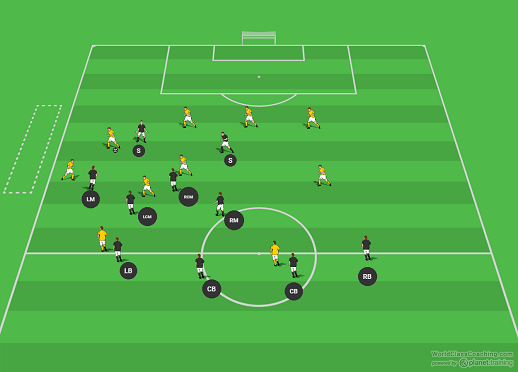
In cases like this, I often designate one of my center backs as the “delayed sweeper”. The moment possession is lost, I instruct this player to drop back like a traditional sweeper would. At the same time, I also instruct the remaining players to apply immediate pressure to the ball and force a quick turnover – either by forcing a short sloppy pass or rushed long ball. The diagram below shows this movement. By rushing numbers to the area around the ball, any inaccurate short passes can be stolen and turned into immediate numbers up possession. IF the opponent takes the bait and sends the ball long, the sweeper is there to either win it clean, clear it or immediately challenge the opposing attacker.
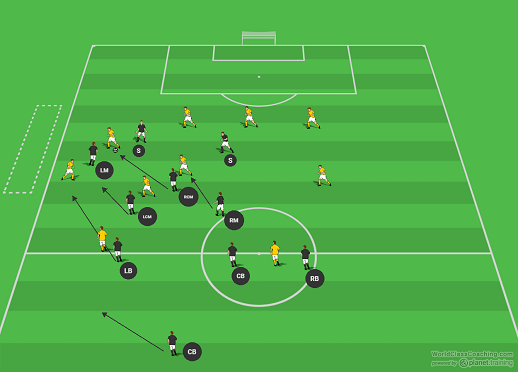
As the final diagram below shows, once possession is regained, the “sweeping” player quickly pushes back up into the defensive line . Designating a player to be the delayed sweeper eliminates confusion between the center backs, allows aggressive man marking with the top 3 defenders, and as the diagram below also shows, allows a midfielder who may usually be focused on marking to aggressively win the ball back ( shown by the left center mid in the diagrams).
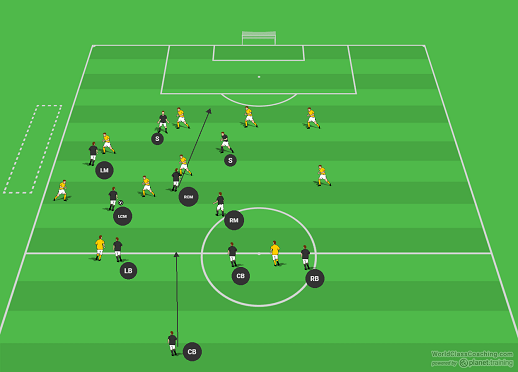
If you think this is a tactic which will help your team, try the following drill to help put it in play for your side.
Lesson 1
7 v 5 Zones
Set Up
On a half field, 7 attackers plus a keeper play a 6 player defending team, without a keeper. Place a 5 yard long restraining zone across the width of the pitch in the center ( as shown ). Play starts with the keeper playing to the 5 attacking players in their defensive third against 3 of the defending team. ( all of these players must stay in this zone ). The attacking team can use two additional players who can play free in the restraining zone and then advance into their attacking end. The focus in this drill are the 3 defending players who must stay in their defensive end, specifically the designated delayed sweeper ( shown shaded ).
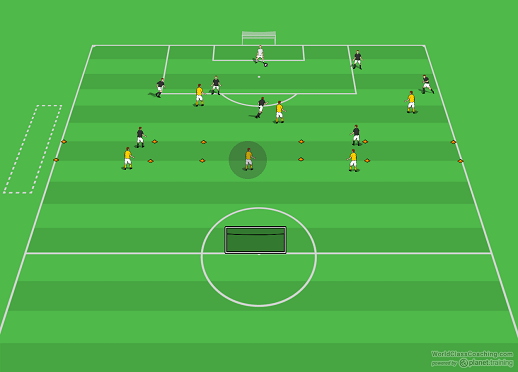
The goal is for the attacking team to send a long ball into the two designated forward players, who must combine in their attacking end to score on the empty net. As the diagram below shows, the idea is for the 5 attackers to easily combine in their defensive end and then send a ball through or over to the on running forward player. The central defender should read the “play” and just before the ball is sent, should sprint back to intercept the pass.
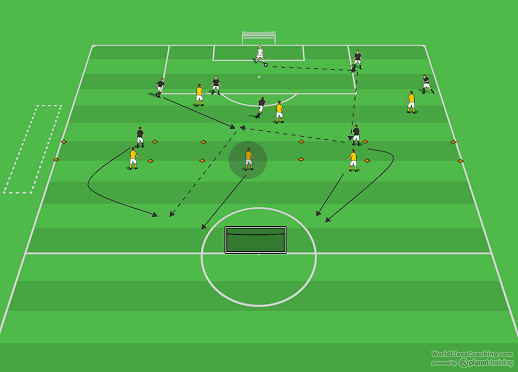
After intercepting the pass, the delayed sweeper should immediately send in a long ball , where the initial attacking team’s central player should act as a delayed sweeper and try to intercept as well ( again shown shaded).
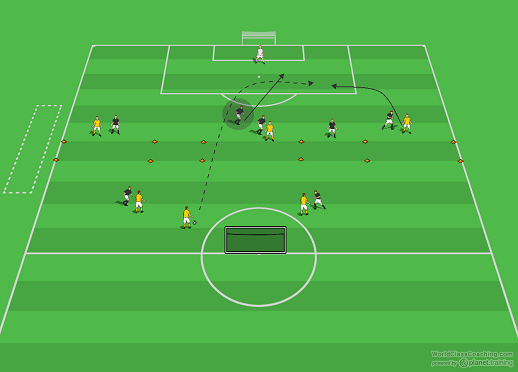
Coaching Points
The main idea here is how the center back designated as the delayed sweeper reads the play. To help this develop, the coach should give the attacking team 10 seconds to send in the long ball and if the defending team intercepts the pass, 3 seconds to send the ball back in. The coach should also make sure the designated delayed sweeper pushes up with the other defenders and does not get caught standing too far back.
By Mike Smith
Currently the Head Coach for University Heights Academy Boys Soccer in Hopkinsville, KY , Mike is in his 14th year as a high school head coach with 23 years coaching experience overall and 34 year as a student and fan of the game. He holds a USSF D License.


